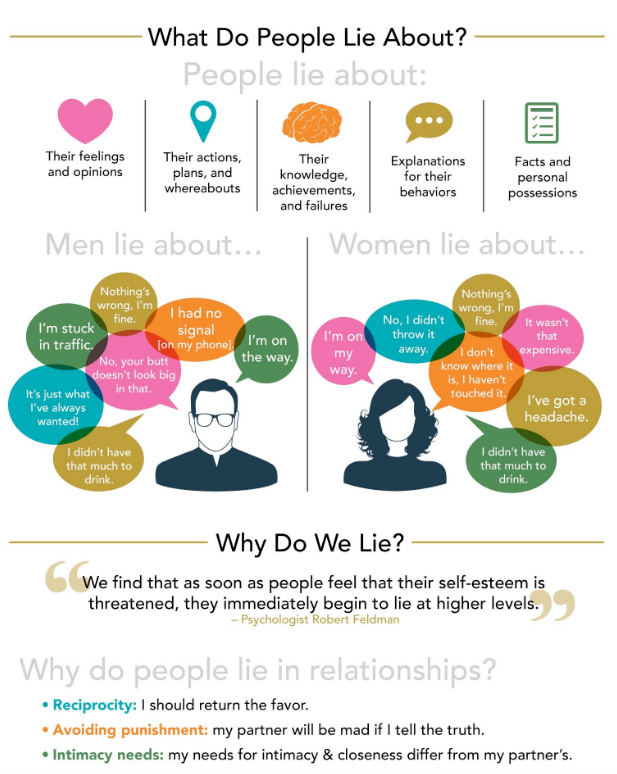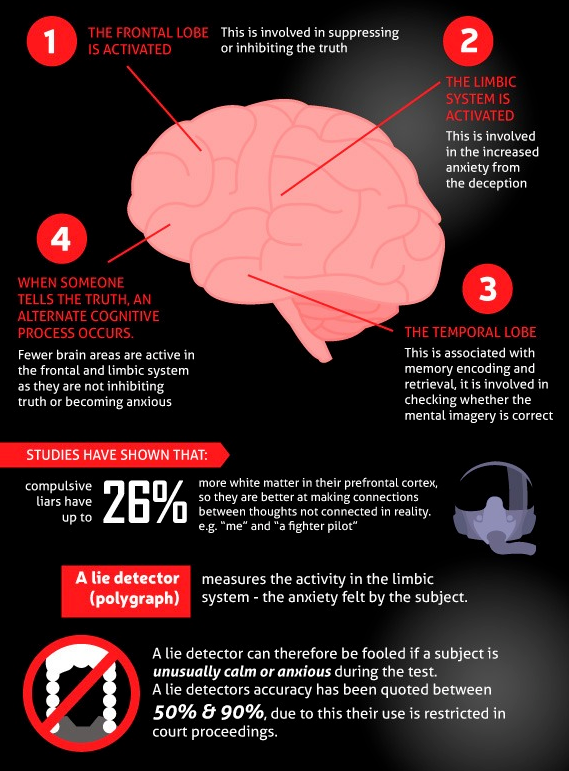
Lying. We do it all the time, often without noticing, and sometimes even to ourself.
Whether it's a white lie, a tiny lie that's just changing the reality a little bit, simply not telling everything you know or a lie to make yourself feel better - humans are natural liars.
Studies have shown that we lie 2-3 times in a 10-minute conversation with a stranger.
A married couple lies to each other every 10 interactions - for a normal relationship, that might even be every 3 interactions.
Now you might be thinking "I don't lie to my partner that often!" but they're not always big lies - in our daily life, these are more things like "I already did the dishwashing for times this week!" when in reality it was 4, or taking 2 cups of free coffee at work when everyone was only allowed one.
But why do we lie so much, how does it change our brain and behaviour, and how do you spot a liar?

History of Lying
Humans are not the only ones that lie - animals do it too.
Although they can't talk, certain species still use tactics to trick others, and gaining an advantage from that.
Humans probably started lying pretty much since the beginnings of our existence.
We are very social beings, and have always lived and survived in groups - so cavemen figured out very soon that they could gain a competitive advantage by lying to or tricking someone else - while still keeping their social standing within the group (as long as the lie wasn't exposed.)
So over time, we got better and better at lying - but also better and better at detecting other's people's lies, to protect ourselves.
While religious institutions tried to encourage telling the truth and medieval torture methods should scare liars off, that still didn't stop humans from lying.
Development of Lies
We develop the ability to lie at around 6 months old - babies often fake-cry to get attention, or achieve what they want. Since then, they keep getting better at it, and studies have shown that by the age of 4, kids are already experienced liars.
Interestingly, studies have shown that we don't only get better at telling lies over time, but it also becomes easier!
With every lie we tell, our brain is being desensitized a little more. The emotional cost of lying and the typical feeling of guilt decrease over time.
So when you don't get caught often, it's easy to just keep lying and benefit from it - you'll feel less guilty the more you keep it up.

Brains of Liars
Recent studies have shown that the brains of pathological liars even show a physical difference in the prefrontal cortex, compared to normal brains.
The brain has both gray and white matter - information is being processed in the area of gray matter, while the white matter consists of tissue that connects different parts of the brain.
Scientists were able to prove that pathological liars had up to 25% more white matter in their prefrontal cortex - this means that they're able to make connections very fast, which allows them to keep up with all the false information they have to remember when constantly telling lies.
BUT it's also been proven that they have 14% less gray matter in the prefrontal cortex area.
This in turn means that they are less able to think critically, and have a hard time rationally considering the consequences of their lies.
This often makes them unsuccessful and unhappy, because they're unable to keep jobs or maintain healthy relationships.

Spotting a Liar
There are hundreds of ways to spot if someone's lying, so I will not go into detail.
But just a few symptoms to look out for:
- Liars tend to use more formal language to make their lie sound more sincere, but at the same time they'll use a simple structure because it's quite hard for our brains to come up with a complex story
- They are more likely to swear or talk in a negative tone
- They try to distance themselves from the situation and avoid using personal pronouns
- Very often the upper body freezes, while they try to keep up a lot of eye contact to seem more honest, and they often smile at the end of telling the fake story.
Images: 1, 2, 3, 4, Sources: 1, 2, 3, 4, 5
- Instagram -

© Sirwinchester
